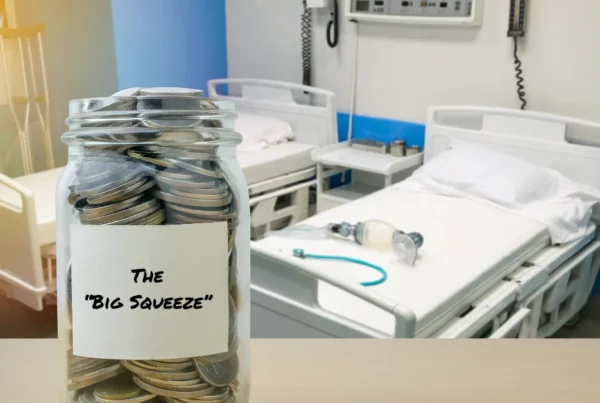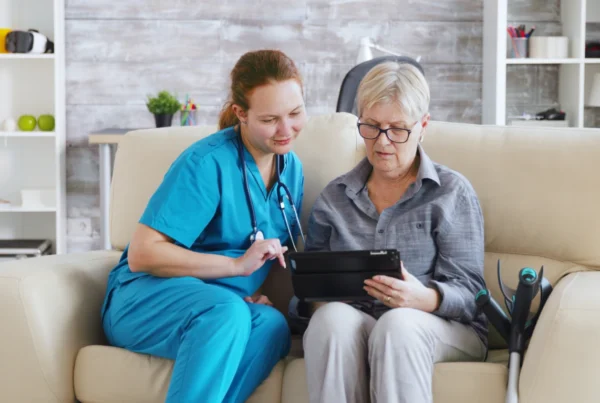
Healthcare organizations constantly seek ways to improve patient care, reduce costs, and streamline operations. A healthcare CMMS is a powerful tool that does just that. By leveraging the latest technology, a CMMS helps caregivers, patients, operational managers, and warehouse workers alike. In this blog post, we’ll explore the many benefits of using a healthcare CMMS, such as minimizing administrative costs, improving the nurse/patient experience, optimized HME/DME rental, and more.
First Things First… What is a Healthcare CMMS?
A computerized maintenance management system (CMMS) is an essential tool for healthcare organizations that want to optimize their operations and provide the highest levels of patient care. CMMS solutions streamline workflows, reduce costs, and automate tedious tasks associated with asset maintenance.
With a CMMS in place, healthcare organizations tracks inventory, schedule preventive maintenance of medical equipment and generate custom forms, manage cycle billing, and much more. This provides better visibility into the organization’s operations, and significantly reduces administrative costs.
The advanced analytics capabilities offered by a CMMS also give staff the ability to identify cost-saving opportunities or areas of improvement quickly and accurately. With a CMMS in place, healthcare organizations ensure their equipment is properly maintained and streamline medical equipment rentals while providing the best possible patient care experience.
By leveraging the power of a CMMS, hospitals, hospice care providers, and other healthcare facilities improve their operational efficiency while reducing costs – all while ensuring high-quality standards for patient care.
Read on to learn more about how a healthcare CMMS:
- Improves the Nurse/Patient Experience
- Minimizes Administrative Costs
- Adds Greater Visibility into Logistics, Orders and Shipping
- Automated custom forms, workflows and scheduling
- Advanced Inventory Management
- Advanced Work Order Management
- Custom Software Integrations
- Management Across All Screens – Desktop, tablet, mobile
- Streamlined DME/HME Rental
- Custom Reporting Dashboards with Advanced Metrics
-
Improve the Nurse/Patient Experience
The nurse/patient experience is at the heart of healthcare operations and should always be a top priority. Utilizing a healthcare CMMS greatly enhances this experience by providing nurses and others on the frontline with patients an efficient, organized way to manage their care.
One of the biggest benefits of using a healthcare CMMS is that it improves communication between nurses, patients, and other staff members, allowing for better collaboration on patient care. It also eliminates the need for manual record-keeping and standardizes data collection, making it easier to track patient information over time. This streamlines the patient intake process and gives nurses more time to focus on providing quality care.
Another way that healthcare CMMS improves the nurse/patient experience is through its ability to automate tasks like scheduling appointments and ordering supplies. This reduces administrative work for nurses, freeing up time to focus on direct patient care. It also helps to ensure that medical supplies are available when needed, reducing wait times and patient friction points.
A CMMS helps ensure compliance with healthcare regulations by providing real-time data that is up-to-date with the latest regulations. With this easily accessible information, nurses know they are following all laws and regulations related to patient care at all times without having to manually check every item or procedure they need to follow.
Using a CMMS reduces errors associated with manual paperwork like typos or incorrect information that could be costly if not corrected in time. Automated and customized forms provide accurate data and ensure you have all the necessary patient information equipment rentals. As a result, this streamlines operations without any delays caused by human error.
-
Minimize Administrative Costs
In today’s healthcare landscape, administrative costs are a major concern for hospitals and other health care organizations. A CMMS is an invaluable asset to help healthcare organizations minimize administrative costs. By streamlining processes, reducing manual paperwork, and generating reports with advanced metrics, the system significantly improves operations at a lower cost.
By automating many tasks, like ordering supplies or scheduling appointments, staff members don’t have to spend as much time dealing with administrative work. This not only reduces labor costs but also minimizes the possibility of errors due to manual data entry.
Another way a healthcare CMMS reduces administrative costs is through improved communication between staff members. By providing an efficient platform for collaboration and sharing information, staff members don’t have to waste time communicating via email or phone calls. Not only does this save on labor costs but it also leads to more effective communication between departments and ultimately reduces errors caused by miscommunication or misunderstanding.
In summary, using a healthcare CMMS is an effective way to minimize administrative costs while improving operational efficiency across the board. From streamlining tasks like data entry and paperwork processing to providing valuable insights into performance analytics and offering access to educational resources for staff member development – this powerful tool has the potential to transform any organization’s approach to cost management while simultaneously enhancing patient care.
-
Add Greater Visibility into Logistics, Orders and Shipping
A CMMS adds greater visibility into logistics, orders and shipping than traditional methods, allowing healthcare organizations to track items from purchase order to delivery while creating alerts for low-stock inventory.
With a CMMS in place, healthcare organizations receive real-time notifications when orders are received or shipped, meaning they may immediately adjust plans if needed. This helps them stay on top of their supply chain operations and be more responsive to patient demands. Additionally, the software optimizes shipping and warehouse management processes by automatically tracking inventory levels and suggesting the best routes for deliveries.
The system also provides visibility into vendor performance, which is essential for keeping costs down and providing the highest quality care possible. By monitoring vendor performance closely with a CMMS solution, healthcare organizations identify issues quickly and take corrective action before it affects patient care. In addition to this functionality, the system also allows users to set up automatic reminders when stock levels are running low or when supplies need replenishing.
A CMMS solution allows healthcare organizations to gain greater insight into their supply chain and logistics operations in one centralized location. With all features combined – from tracking purchase orders through delivery, creating alerts for low stock levels, optimizing shipping routes, and warehouse management processes – a CMMS helps ensure that medical supplies arrive on time so that patient care isn’t compromised.
Finally, having a well-designed system for logistics gives organizations the ability to track shipments in real-time from start to finish. Knowing exactly where items are in transit helps prevent potential delays or errors due to miscommunication between departments or vendors. By leveraging the power of a healthcare CMMS, organizations have an up-to-date view of all shipments which leads to greater accuracy and efficiency in their operations overall.
-
Automated custom forms, workflows and scheduling
Automating custom forms, workflows and scheduling with a healthcare CMMS helps organizations save time, money, and resources while improving patient care. By automating these tasks, organizations reduce manual labor and errors while ensuring that all relevant data is entered into the system accurately and quickly.
Additionally, automated forms make it easy to keep track of patient information in one centralized location, providing instant access to up-to-date records. Automated workflows also streamline processes across departments and enable personnel to quickly identify any areas that need improvement or adjustment.
Automated custom forms, workflows and scheduling are not only efficient but also secure. Healthcare organizations must take measures to ensure the privacy of their patients’ data; this includes protecting sensitive information from unauthorized access or modification. A healthcare CMMS provides an extra layer of security by automatically encrypting all data entered into the system – ensuring that all confidential information remains safe from cyber threats.
-
Advanced Asset Management
As healthcare organizations grow, managing inventory becomes increasingly complex. The manual process of tracking and ordering supplies often leads to costly overstocking or shortages. However, a CMMS solution addresses this challenge. With a CMMS in place, healthcare organizations minimize their inventory costs and minimize the risk of overstocking or running out of critical supplies.
Using a CMMS for asset management provides real-time insights into inventory levels, allowing users to monitor stock levels from one centralized location. This enables them to be more proactive and restock supplies before they run out, helping them avoid disruption in service. Additionally, the system tracks usage of each item so that healthcare organizations have an accurate view of future demand for each product. This helps them make better decisions when it comes to budgeting for new purchases and reducing waste due to overbuying or underbuying materials.
Finally, utilizing automated restocking processes with a healthcare CMMS dramatically improves efficiency within an organization’s supply chain operations. By setting thresholds for low-stock levels based on historical data or customer demand forecasts, organizations automatically generate restock orders when needed without manual intervention. This allows personnel to spend less time tracking orders and more time focusing on other important tasks like providing patient care or managing financial resources.
-
Advanced Work Order Management
Advanced work order management is essential for any healthcare organization that requires routine upkeep of their equipment and facilities. A CMMS provides the tools necessary to track and monitor work orders, assign tasks to personnel, generate custom reports on progress and completion, as well as integrate with existing systems for a seamless workflow.
Real-time tracking of work orders allows users to stay up-to-date on which tasks are accepted or rejected by employees, and when they have been completed.
Quality control is another area where CMMS excels – it provides built-in features that allow users to monitor compliance standards across an entire project from start to finish. This ensures operations meet industry regulations such as OSHA, HIPPA, and The Joint Commission while minimizing risks associated with noncompliance issues.
-
Custom Software integrations
Custom software integrations allow organizations to connect existing systems, such as hospital EMRs, with the CMMS. This creates a unified platform for managing patient information and medical equipment data. Leveraging the power of these integrations allows users to access data from any connected device. This also helps eliminate redundant tasks such as entering the same information multiple times in different formats or locations.
In addition, an API enables integration with any third-party software. Consequently, organizations are able to take advantage of all the features of the CMMS without replacing existing systems; making it particularly useful for larger healthcare organizations with complex IT infrastructures.
Custom software integrations also make it easier for IT teams to deploy new systems quickly and efficiently – without having to spend hours setting up complex configurations manually every time they want to add a new application or update an existing one. This reduces risk for potential security breaches or unauthorized accesses as the system remains secure even when changes are made in the background.
Overall, leveraging a CMMS combined with custom software integrations is an invaluable tool for health care organizations looking for operational efficiency gains whilst meeting industry standards & delivering better patient care services.
-
Management Across All Screens – Desktop, tablet, mobile
Healthcare organizations today face the challenge of providing top-notch patient care in a fast-paced environment. To ensure this, they need to access and manage their system from any device, anytime, anywhere. An all-in-one CMMS solution is the answer. It eliminates the need for multiple software solutions designed for each device and ensures that the user experience remains consistent across all screens with its intuitive UI.
Desktop users enjoy a comprehensive suite of features that allow them to manage their entire maintenance program in real-time without having to leave the office. Tablets and mobile devices offer similar capabilities, but with the added convenience of being able to access them from anywhere. This means that on-the-go staff will make updates as needed via their phones or tablets.
The secure architecture of a CMMS provides data privacy measures that help protect patient information from unauthorized access while ensuring compliance with national healthcare regulations such as HIPAA, OSHA, and The Joint Commission. By using integrated authentication systems such as SSO (Single Sign On), healthcare organizations ensure secure access to confidential data at all times while maintaining high levels of reliability and scalability.
-
Streamlined DME/HME Rental
With a healthcare CMMS, all rental requests are tracked in one convenient system, providing staff with real-time visibility into which items have been rented out and when they need to be returned. This helps eliminate wasted time spent on manual follow-ups or inaccurate tracking. It allows staff to quickly review past records and determine how often certain items are being rented out – information that used to optimize inventory levels or review pricing strategies.
Not only does streamlined DME/HME rental help reduce costs associated with ordering and delivering the necessary items, but it also ensures that each item is delivered correctly and on time. By tracking items from order placement to delivery, healthcare organizations minimizes costly mistakes while ensuring compliance with the relevant regulations.
With the power of cycle billing, organizations automate billing for recurring orders that aren’t typical one-time purchases. This integration allows staff to track customer invoices and payments from within the same system – eliminating tedious manual data entry tasks while ensuring accuracy across all platforms.
-
Custom Reporting Dashboards with Advanced Metrics
Custom reporting dashboards with advanced metrics is one of the biggest advantages of implementing a healthcare CMMS. Advanced analytics capabilities allow staff to evaluate performance and make informed decisions based on real-time data. The system tracks and analyzes key metrics enabling facilities to identify areas for improvement, measure productivity levels, and compare performance against set goals or benchmarks.
Advanced analytics on asset performance, inventory utilization and workforce productivity are also available through a CMMS. These analytics enable healthcare organizations to identify performance trends and areas needing improvement so efficiency levels are high and costs are low.
Besides tracking key metrics, custom reporting also enables staff to generate reports that are tailored specifically to their needs. By combining essential data points into comprehensive reports, staff gains valuable insights regarding the performance of their organization and how it compares against other locations across the country or even globally within the same organization.
Finally, optimized forecasting capabilities enable healthcare organizations to predict future needs with great accuracy and manage resources accordingly. Advanced analytics allow users to plan ahead in order to anticipate changing demands while still maintaining optimal inventory levels at all times.
How to Choose the Right Healthcare CMMS for Your Organization?
Choosing the right CMMS for your healthcare organization can be a daunting task. With so many options available, it will take hours of research and planning to determine which one is best for your organization.
Not all computerized maintenance management systems offer the same support to meet the needs of national and enterprise-level providers.
For over 30 years, Wynne Systems has been providing solutions to help enterprise brands identify needs and pain points, as well as develop solutions to revolutionize their healthcare operations.
Let us help you make the right choice for your CMMS. Get in touch with one of our experts today to learn more.




